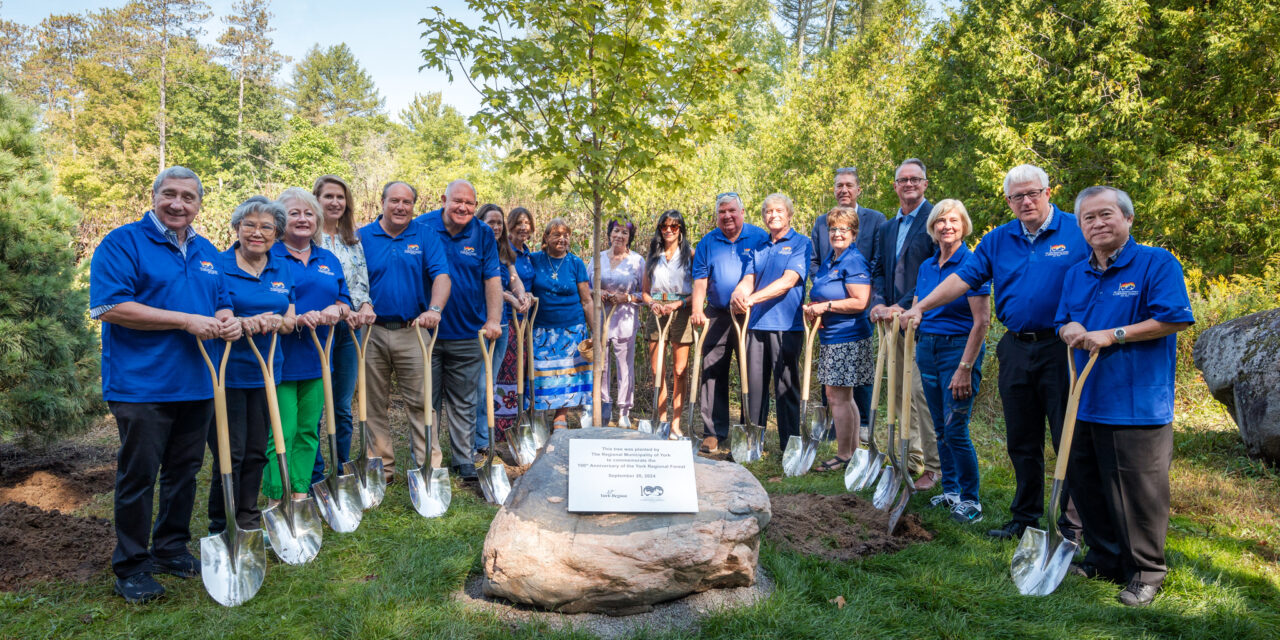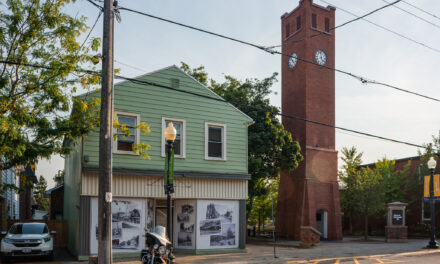- On Friday, September 20, York Region hosted an event at Stouffville’s Hollidge Tract to celebrate the York Regional Forest’s first 100 years.
- Three ceremonial trees were planted by York Region, the Province of Ontario, and the Chippewas of Georgina Island.
- Politicians from York Region and Chief Donna Big Canoe spoke to the history of the Forest and its preservation, and Regional Staff offered guided tours.
Today, York Region politicians were joined by Indigenous representatives, members of the Region’s Forestry department, and Regional and municipal staff for an event commemorating the 100 year anniversary of the York Regional Forest system.
Speakers included Stouffville Mayor Iain Lovatt, President of Ontario’s Treasury Board and Minister of Francophone Affairs Caroline Mulroney, York Region Chairman Wayne Emmerson, and Chippewas of Georgina Island First Nation Chief Donna Big Canoe.
The event took place at the Hollidge Tract in Stouffville, which was the first tract to be established and the first to include a fully accessible trail. Since its inception in 1924, the York Regional Forest has grown to include 24 tracts and over 150 kilometres of trails.
Elder Susan provided a prayer and York Region Indigenous Relations Advisor Lauri Hoeg sang an honour song for the Forest. Ceremonial trees meant to mark the occasion had already been planted and received a smudging ceremony. A sugar maple was planted by York Region, a white pine by the Province of Ontario, and a white birch by the Chippewas of Georgina Island.
“Together, these trees highlight our collective commitment to environmental sustainability and symbolize the growth and longevity of the forest and its importance to our communities,” Mayor Lovatt told the crowd.
Minister Mulroney noted her Treasury Board responsibilities regarding the allocation of funding and highlighted successes achieved through government partnership. She thanked Regional officials and volunteers for their stewardship.
“This is an incredible milestone that underscores the importance of preserving and protecting our natural spaces across Ontario,” Minister Mulroney stated. “It’s also a testament to the power of collaboration, and an outstanding example of what is possible when provincial, regional, and municipal governments work together.
Chairman Emmerson thanked the Regional Forestry division to much applause. “This is more than just a celebration of nature. It’s a recognition of the vision, dedication, and stewardship that have shaped this forest and the surrounding landscapes over the past century,” he explained.
After expressing gratitude for the opportunity to attend, Chief Big Canoe presented an alternative perspective to the audience. “I’m grateful to be here and honour the forest that’s been preserved for one hundred years–I’d say maybe even longer,” she said. “Could you imagine if this forest could talk? What would it tell us about what’s been happening over those hundred years?”
“As leaders, we need to set examples for protecting the environment and the land. With all the development going on, we need to make sure we protect the forests,” she added. “We need to preserve a lot more than just one area…we need to grow, but we can do that in a healthy way, as well as managing what we need to keep here on Mother Earth.”
Following remarks, a tobacco offering, and photographs taken with the newly planted trees, brief tours along the Hollidge Tract’s accessible trail were offered. James Lane, the Manager of Natural Heritage and Forestry at York Region, led the first group and offered more on the Forest’s past and future.
Lane began by recognizing the presence of First Nations peoples long before the Regional Forest began. He explained how, following European settlements beginning in the 1700s, large swaths of Ontario’s forests were cleared for agriculture and timber production.
“Some of those areas, like the Oak Ridges Moraine [we are on], have very sandy soils. Over hundreds of years of agriculture, those soils really got depleted,” he detailed. With soils unable to sustain long term farming, desert conditions resulted and the agricultural system collapsed.
“People’s wells started to dry up, there were droughts, there were flash floods, because trees are such an important and integral part of the landscape here,” Lane continued. “Fast forward to the end of the 1800s, early 1900s, and this got recognized as a significant issue.”
The Ontario government saw the importance of trees in restoring the degraded landscape, and a program was created that provided forest restoration for municipalities willing to purchase lands for preservation. “That program was really how the York Regional Forest was born,” Lane noted.
With the growth of the Forest over the last century, Lane is looking ahead to continued management of the tracts with a goal of returning them to a majority of native hardwoods. Species such as sugar maples require shade to germinate, grow, and establish effectively, so more tolerant species like red pine were planted first to stabilize the soil and develop an initial canopy.
Rows of red pines in the Hollidge Tract were planted in April of 1924, according to Lane, and they are slowly being thinned. Over the next 80-120 years, Lane hopes the non-native trees will mostly be removed from the Forest and replaced with native hardwoods like oak, beech, and sugar maple.
As the tour ended, Lane highlighted how these last 100 years are a relatively brief moment in the history of the York Regional Forest.
“The movement from pine back to native hardwood will be the second milestone,” he said. “There’s hundreds of years ahead of us for succession…to see these trees grow, mature, and get that forest structure that we would have seen before it was cleared.”





